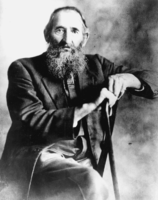
Feudist Anderson ‘‘Devil Anse’’ Hatfield (September 9, 1839-January 6, 1921) was patriarch of the Hatfield family and their leader during the Hatfield-McCoy feud. He was born in present Mingo County. He married Levicy Chafin in 1861, and they had 13 children. Hatfield fought for the South in the Civil War, serving in the Logan Wildcats, an irregular group, and in the regular Virginia infantry. He deserted the infantry in 1863.
Hatfield was an imposing figure, six feet tall or taller. Military records describe him as having dark hair, dark eyes, and a dark complexion, and for most of his life he wore a full, dark beard. He was an outdoorsman and an avid bear hunter. His name is usually given as William Anderson Hatfield in the secondary sources, but he consistently used just Anderson. Various stories account for his colorful nickname, which distinguished him from cousin Anderson ‘‘Preacher Anse’’ Hatfield.
The Logan Wildcats were suspected in the 1865 murder of Kentuckian Harmon McCoy, a Union army veteran and brother of McCoy patriarch Randolph McCoy. Hatfield’s uncle, Jim Vance, was a more likely culprit in this than Hatfield himself. Likewise, Hatfield had no personal involvement in a famous 1878 hog-stealing incident and trial. In 1880, he led the armed party rescuing son Johnse Hatfield from the brothers of Rose Anna McCoy. He took a decisive role in the bloody events of 1882, when brother Ellison Hatfield was mortally wounded in a drunken election-day brawl and three sons of Randolph McCoy were killed in retaliation. Hatfield was the leader in this decision and likely took part in the killings. Indicted in the crime, he was never tried.
Hatfield instigated but did not take part in the January 1, 1888, nighttime raid on the McCoy cabin. Calvin and Alifair, Randolph McCoy’s grown children, were killed in the New Year’s raid, and their mother, Sarah, bludgeoned. This atrocity brought matters to a head, putting the Hatfields on the defensive for the remainder of the conflict. Eventually four Hatfield sons and others were indicted for the cabin raid, and their cousin, Ellison Mounts, was hanged. This ended the family war.
Hatfield identified himself as a farmer to census takers and military recruiters, and he worked at farming and logging. In fact, he was a major property owner and increasingly a man of affairs as his many sons took up the physical work of the family. Troubled as the feud wore on, he interspersed attempts at peacemaking with continued aggression. He relished his growing celebrity, making himself available to the press and the public. Certain interviews of his, particularly with the Wheeling Intelligencer and with New York World reporter T. C. Crawford, helped to sensationalize the vendetta.
Devil Anse Hatfield lived many years after the feud. He was baptized by his old friend, preacher ‘‘Uncle Dyke’’ Garrett, in 1911. He is buried under a life-size statue of himself in Logan County.
Last Revised on November 30, 2012
Related Articles
Sources
Rice, Otis K. The Hatfields and the McCoys. Lexington: University Press of Kentucky, 1982.
Hatfield, Coleman & Robert Y. Spence. The Tale of the Devil: The Biography of Devil Anse Hatfield. Chapmanville: Woodland Press, 2003.
Waller, Altina L. Feud: Hatfields, McCoys, and Social Change in Appalachia, 1860-1900. Chapel Hill: University of North Carolina Press, 1988.
Cite This Article
e-WV: The West Virginia Encyclopedia "Devil Anse Hatfield." e-WV: The West Virginia Encyclopedia. 30 November 2012. Web. 21 October 2024.



Comments?
There aren't any comments for this article yet.
Click here to read and contribute to the discussion →